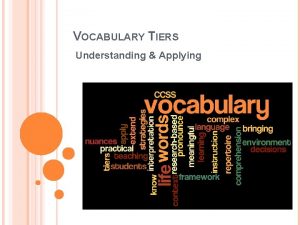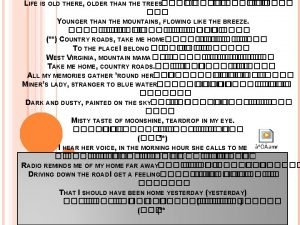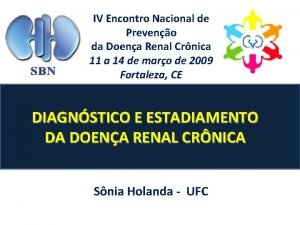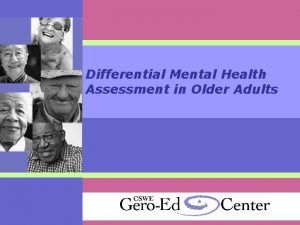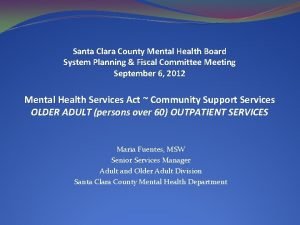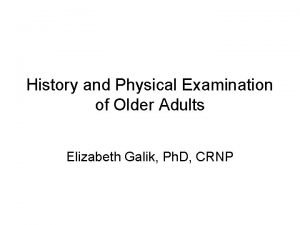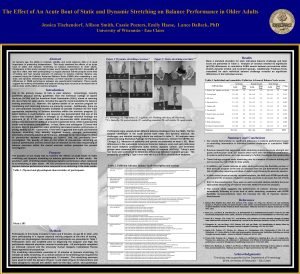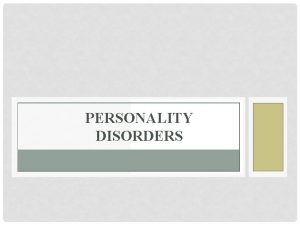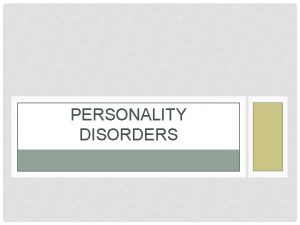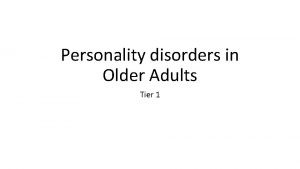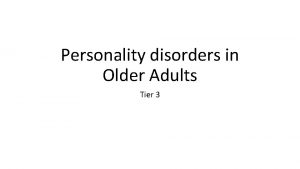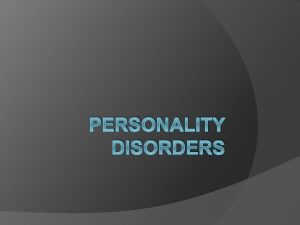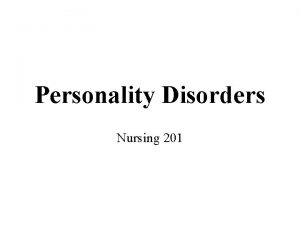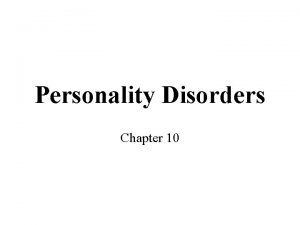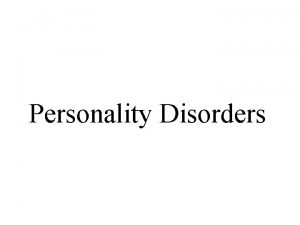Personality disorders in Older Adults Tier 2 What












- Slides: 12

Personality disorders in Older Adults Tier 2

What is Personality? The word ‘Personality’ refers to the collection of characteristics or traits that we have developed as we have grown up and which make each of us an individual. These include the ways that we: • think • feel • behave

Individuals with Personality disorders/ complex emotional needs • Personality disorder refers to pervasive disturbances within a person’s personality and behaviour, which can make it difficult for them to live with themselves and/or other people and negatively impacts on their social functioning and relationships. • Personality disorders can have a significant impact the ability to respond to life stresses. • People with a personality disorder can feel stigmatised because of this diagnosis and some prefer the use of the term having complex emotional needs instead

Prevalence of personality disorders (PD) • Older adults are less likely to attract a diagnosis of “personality disorder” so exact prevalence is unknown • Prevalence could be around 10% of an older community population • Overall: Males more than females • Most common PD types in old age: Obsessive-compulsive, avoidant and paranoid.

Types of Personality disorders tend to fall into three groups, according to their emotional 'flavour’: Cluster A disorders 'Odd or Eccentric’ (Paranoid, Schizoid, schizotypal) seem to remain stable as one gets older although rigid behaviour or suspicion may increase Cluster B disorders 'Dramatic, Emotional, or Erratic’ (borderline, histrionic, narcissistic and antisocial) - tend to decrease as one gets older Cluster C disorders 'Anxious and Fearful’ (Avoidant, Dependent, Obsessive– compulsive) - seem to remain stable as one gets older

Recent personality changes may however not be due to personality disorder but rather can be due to: Medical or organic cause • Cerebrovascular event • Infection – meningitis • Head Trauma • Brain tumour • Dementia Prescribed Medications • Steroids Mental illness • Depression/Mania Illegal drugs and/ or alcohol

Reasons for presentation Why personality disorders may present in later life • They may loose the significant other who has contained or compensated for the personality disorder in the other person • A move to long term care • Loss of a stabilising situation • Increased use of alcohol and prescription drugs • Retriggering of trauma • Bereavement and losses including loss of jobs/ roles • Difficulty in adapting to ageing

Challenges for the older adult Challenges for an older adult with personality disorder • Worse physical functioning • Greater use of medication • More unstable/brief relationships • Increased chances of being discharged to a residential placement and ongoing challenges with forming relationships with carers • More likely to have other mental health difficulties, like depression and anxiety • Less responsive to treatment for any of their other mental illnesses • Older people with Personality Disorder make up 44% of completed suicides

Challenges for the teams caring for an older person with personality disorder • Staff receive a lot more calls from this cohort • They may repeatedly ask for prescription medication • They may have frequent attendance at A&E • The increased somatization and demands for care from staff/ family can lead to team frustration and longer admissions • They can lead to splitting among the team members (this is when staff begin disagreeing amongst themselves about the best way to support the person )

Core components of support for older adults with personality disorders • Establish and understand the importance of therapeutic relationship • Treat the older person’s comorbidities (e. g. anxiety, depression) • Establish good links with other professionals - Have a joined up model between community and inpatient services • Involve significant others where possible • Use supportive cognitive psychotherapy which may help the older person to acknowledge some of these issues and work on them

Core components of support Ensure the care team use a systemic approach that fosters • Consistency, • Containment, • Empowerment, • Compassion.

References • Personality disorders in later life: epidemiology, presentation and management Ayesha Bangash BJPsych Advances (2020), vol. 26, 219 – 220 doi: 10. 1192/bja. 2020. 19 • Late-onset personality disorder: a condition still steeped in ignorance Peter Tyrer & Robert Howard BJPsych Advances (2020), vol. 26, 219– 220 doi: 10. 1192/bja. 2020. 19
 Tier 1 2 3 vocabulary words
Tier 1 2 3 vocabulary words Tier 2 and tier 3 words
Tier 2 and tier 3 words Life is older than the trees
Life is older than the trees Older adults
Older adults Mental health and older adults
Mental health and older adults Covids older adults
Covids older adults Altered cognition in older adults is commonly attributed to
Altered cognition in older adults is commonly attributed to Older adults mental health
Older adults mental health Shingles older adults
Shingles older adults Dynamic stretching for older adults
Dynamic stretching for older adults Mental health and older adults
Mental health and older adults Carla homulka
Carla homulka Personality disorders dsm 5
Personality disorders dsm 5
